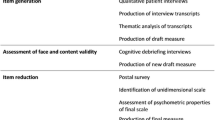Treatment satisfaction is used to capture the full impact of disease on patients’ lives. Currently, no instruments exist to evaluate satisfaction with pharmacologic therapy in patients with Crohn’s disease (CD). The purpose of this study was to evaluate the psychometric properties of a treatment satisfaction questionnaire for CD (TSQ-C). The 36-item questionnaire was completed by CD patients who reported taking 5-aminosalicylic acid derivatives to treat their CD. Measures used in the validation study were the Inflammatory Bowel Disease Questionnaire (IBDQ), Crohn’s Work Activity Impairment Index (CWAII), and patient reports of clinical indicators (e.g., number of active flares and medications taken). Exploratory factor analysis was used to evaluate the items and subscale structure. Internal consistency reliability and concurrent and discriminant validity were assessed using Cronbach’s alpha, Pearson correlation coefficients, and analysis of variance. A total of 813 CD patients participated, with the majority being Caucasian (95.9%), female (67.0%), and ≥34 years old (86.1%). Patient-rated severity of CD was mild (49.3%), moderate (41.7%), and severe (7.5%). The final TSQ-C consisted of 32 items, with six subscales (Symptoms, Satisfaction, Expectations, Physician Relationships, Bother, and Cost), with each subscale score ranging from 1 to 6. Cronbach’s α values ranged from 0.63 (Cost) to 0.94 (Symptoms). Strong correlations were observed among the IBDQ, CWAII, and the Satisfaction and Symptoms subscales of the TSQ-C. TSQ-C subscales, particularly Symptoms and Satisfaction, significantly discriminated among levels of number of flares per year, patient-rated disease severity, and number of medication classes. The TSQ-C demonstrated excellent validity and reliability and appears to be a useful tool for evaluating satisfaction with pharmacologic therapy among patients with CD.
Similar content being viewed by others
References
Weinberger M, Oddone EZ, Henderson WG: Does increased access to primary care reduce hospital admissions? Veterans Affairs Cooperative Study Group on Primary Care and Hospital Readmission. N Engl J Med 334(22):1441–1447, 1996
Ross CK, Sinacore JM, Stiers, et al.: The role of expectations and preferences in health care satisfaction of patients with arthritis. Arth Care Res 3:92–98, 1990
Sherbourne CD, Hays RD, Ordway L, et al.: Antecedents of adherence to medical recommendations: results from the Medical Outcomes Study. J Behav Med 15:447–468, 1992
Bartlett EE, Grayson M, Barker R, et al.: The effects of physician communications skills on patient satisfaction, recall, and adherence. J Chron Dis 37:755–764, 1984
Telander RL, Spencer M, Perrault J, et al.: Long-term follow-up of the ileoanal anastomosis in children and young adults. Surgery 108:717–723, 1990
Scottt HJ, Northover JM: Evaluation of surgery for perianal Crohn’s fistulas. Dis Colon Rectum 39:1039–1043, 1996
Taylor BM, Beart RW, Dozios RR, et al.: Straight ileoanal anastomosis v ileal pouch—anal anastomosis after colectomy and mucosal protectomy. Arch Surg 118:696–701, 1983
Guyatt G, Mitchel A, Irvine EJ, et al.: A new measure of health status for clinical trials in inflammatory bowel disease. Gastroenterology 96:804–810, 1989
Irvine et al.: 1994.
Reilly Associates: Work Productivity and Activity Impairment Questionnaire (CWAII) User’s Manual. 2001
Mulaik SA: The Foundations of Factor Analysis. New York, McGraw–Hill, 1972
Cronbach LJ: Coefficient alpha and the internal structure of tests. Psychometrika 16:297–334, 1951
Weaver M, Patrick DR, Markson LE, et al.: Issues in the measurement of satisfaction with treatment. Am J Man Care 3:579–594, 1997
Huskisson EC, Bernstein RM, Coppock JS, et al.: Enteric coated naproxen: a double blind trial comparing the tolerance of enteric coated and standard formulations. Eur J Rheumatol Inflam 12:27–30, 1992
Bradley C, Lewis KS: Measures of psychological well-being and treatment satisfaction developed from the responses of people with tablet-treated diabetes. Diabetic Med 7:445–451, 1990
Streiner DL, Norman GR: Health Measurement Scales: A Practical Guide to Their Development and Use, 2nd ed. New York, Oxford University Press, 1995
Nunnally JC, Bernstein IH: Psychometric Theory, 3rd ed. New York, McGraw–Hill, 1994
Author information
Authors and Affiliations
Corresponding author
Rights and permissions
About this article
Cite this article
Coyne, K., Joshua-Gotlib, S., Kimel, M. et al. Validation of the Treatment Satisfaction Questionnaire for Crohn’s Disease (TSQ-C). Dig Dis Sci 50, 252–258 (2005). https://doi.org/10.1007/s10620-005-1591-3
Received:
Accepted:
Issue Date:
DOI: https://doi.org/10.1007/s10620-005-1591-3




